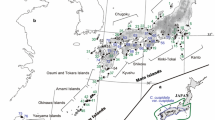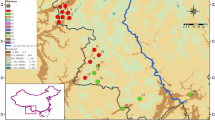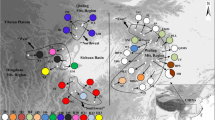Abstract
Big-leaf mahogany (Swietenia macrophylla King) is one of the most valuable and overharvested timber trees of tropical America. In order to better characterize geographic patterns of genetic variation, we performed a phylogeographic analysis of S. macrophylla based on six polymorphic chloroplast genome simple sequence repeat loci (cpSSRs) analyzed in 16 populations (N = 245 individuals) distributed across Central America and the Brazilian Amazon. Of the 31 total cpDNA haplotypes identified, 16 occurred in Central America and 15 in Amazonia with no single haplotype shared between the two regions. Populations from Central America showed moderate differentiation (F ST = 0.36) while within population genetic diversity was generally high (mean Nei’s H E = 0.639). In contrast, the Amazonian populations were strongly differentiated (F ST = 0.91) and contained relatively low genetic diversity (mean H E = 0.176), except for one highly diverse population (H E = 0.925) from eastern Amazonia. Spatial analysis of molecular variance (SAMOVA) identified a single Central American phylogroup and four Amazonian phylogroups, indicating stronger phylogeographic structure within Amazonia. The results demonstrate distinctive regional patterns of S. macrophylla differentiation, and the first evidence of a strong phylogeographic break between Central American and South American mahogany populations. We suggest that the frequent occurrence of hurricanes in Central America, the differences in the glacial histories and in the duration and intensity of anthropogenic disturbance during the late Holocene may have played important roles in the geographic structuring of cpDNA lineages in the two regions. The high private haplotype diversity in Brazilian populations suggests that cpSSRs can be used as DNA barcodes for regional timber certification.


Similar content being viewed by others
Abbreviations
- cpDNA:
-
chloroplast genome
- cpSSR:
-
simple sequence repeats of the chloroplast genome
- AMOVA:
-
Analysis of molecular variance
- SAMOVA:
-
Spatial analysis of molecular variance
- CITES:
-
Convention on International Trade in Endangered Species
References
Balée W (2006) The research program of historical ecology. Annu Rev Anthropology 35:75–98
Bandelt HJ, Forster P, Rohl A (1999) Median-joining networks for inferring intraspecific phylogenies. Mol Biol Evol 16:37–48
Birky CW (1995) Uniparental inheritance of mitochondrial and chloroplast genes: mechanisms and evolution. Proc Natl Acad Sci USA 92:11331–11338
Bush MB, Oliveira PE (2006) The rise and fall of the Refugial Hypothesis of Amazonian Speciation: a paleo-ecological perspective. Biota Neotropica 6(1):bn00106012006
Bush MB, Silman MR (2004) Observations on Late Pleistocene cooling and precipitation in the lowland Neotropics. J Quaternary Sci 19:677–684
Cavers S, Navarro C, Lowe AJ (2003) Chloroplast DNA phylogeography reveals colonization history of a Neotropical tree, Cedrela odorata L., in Mesoamerica. Mol Ecol 12:1451–1460
Colinvaux PA, De Oliveira PE, Moreno JE, Miller MC, Bush MB (1996) A long pollen record from lowland Amazonia: forest and cooling in glacial times. Science 274:85–88
Colinvaux PA, Irion G, Räsänen ME, Bush MB, Nunes De Mello JAS (2001) A paradigm to be discarded: geological and paleoecological data falsify the Haffer and Prance refuge hypothesis of Amazonian speciation. Amazoniana 16:609–646
Cornelius J, Navarro C, Whightman K, Ward S (2005) Is mahogany dysgenically selected? Environ Conserv 32:129–139
Deguilloux MF, Pemonge MH, Petit RJ (2002) Novel perspectives in wood certification and forensics: dry wood as a source of DNA. Proc R Soc Lond B Biol Sci 269:1039–1046
Denevan WM (1992) The pristine myth: the landscape of the Americas in 1492. Ann Assoc Am Geogr 82:369–385
Denevan WM (2001) Cultivated landscapes of Native Amazonia and the Andes. Oxford University Press, New York
Dick CW, Heuertz M (2008) The complex biogeographic history of a widespread tropical tree species. Evolution 62:2760–2774
Dick CW, Kress WJ (2009) Dissecting tropical plant diversity with forest plots and a molecular toolkit. Bioscience 59:745–755
Dick CW, Abdul-Salim K, Bermingham E (2003) Molecular systematics reveals cryptic Tertiary diversification of a widespread tropical rainforest tree. Am Nat 162:691–703
Doyle JJ, Doyle JL (1987) Isolation of plant DNA from fresh tissue. Focus 12:13–15
Dupanloup L, Schneider S, Excoffier L (2002) A simulated annealing approach to define de genetic structure of populations. Mol Ecol 11:2571–2581
Ennos RA, Sinclair WT, Hu X-S, Langdo A (1999) Using organelle markers to elucidate the history, ecology and evolution of plant populations. In: Hollingsworth PM, Bateman RM, Gornall RJ (eds) Molecular Systematics and Plant Evolution. Taylor & Francis Ltd, London
Erickson C (2006) Domesticated landscapes of the Bolivian Amazon. In: Balée W, Erickson C (eds) Time and complexity in historical ecology: studies in the Neotropical lowlands. Columbia University Press, New York
Excoffier L, Smouse PE, Quattro JM (1992) Analysis of molecular variance inferred from metric distances among DNA haplotypes: application to human mitochondrial DNA restriction sites. Genetics 131:479–491
Forster P, Bandelt HJ, Rohl A (2000) NETWORK 3.1.1.0. Software free available via www.fluxus-engineering.com. Fluxus Technology Ltd., Cambridge.
Grogan J (2001) Big-leaf mahogany (Swietenia macrophylla King) in southeast Para, Brazil: a life history study with management guidelines for sustained production from natural forests. PhD thesis, Yale University, New Haven, CT, USA
Grogan J, Barreto P (2005) Big-leaf mahogany on CITES Appendix II: big challenge, big opportunity. Conserv Biol 19:973–976
Grogan J, Barreto P, Verıssimo A (2002) Mogno na Amazonia Brasileira: Ecologia e Perspectivas de Manejo. IMAZON, Belém, PA
Grogan J, Ashton MS, Galvão J (2003) Big-leaf mahogany (Swietenia macrophylla) seedling survival and growth across a topographic gradient in southeast Pará, Brazil. For Ecol Manag 186:311–326
Gullison RE, Panfil SN, Strouse JJ, Hubbell S (1996) Ecology and management of mahogany (Swietenia macrophylla King) in the Chimanes Forest, Beni, Bolivia. Bot J Linn Soc 122:9–34
Hardesty BD, Dick CW, Hamrick JL, Degen B, Hubbell SP, Bermingham E (2010) Geographic influence on genetic structure in the widespread Neotropical tree, Simarouba amara (Simaroubaceae). Tropical Plant Biol 3(1):28–39
Haffer J (2008) Hypotheses to explain the origin of species in Amazonia. Braz J Biol 68(4, Suppl):917–947
Heckenberger MJ, Kuikuro A, Kuikuro UT, Russell JC, Schmidt M, Fausto C, Franchetto B (2003) Amazonia 1492: pristine forest or cultural parkland. Science 301:1710–1714
Heckenberger MJ, Russell JC, Toney JR, Schmidt MJ (2007) The legacy of cultural landscapes in the Brazilian Amazon: implications for biodiversity. Philos Trans R Soc Lond, Ser B 362:197–208
Hodell DA, Curtis JH, Brenner M (1995) Possible role of climate in the collapse of classic Maya civilization. Nature 375:391–394
Hodell DA, Brenner M, Curtis JH (2000) Climate change in the northern American tropics and subtropics since the last ice age. In: Lentz DL (ed) Imperfect balance: landscape transformations in the Precolumbian Americas. Columbian University Press, New York
Holdrige LR, Grenke WC, Hatheway WH, Liang T, Tosi JA (1971) Forest environments in tropical life zones: a pilot study. Pergamon Press, Oxford
Idury RM, Cardon LR (1997) A simple method for automated allele binning in microsatellite markers. Genome Res 7:1104–1109
Islebe GA, Hooghiemstra H, Brenner M, Curtis JH, Hodell DA (1996) A Holocene vegetation history from lowland Guatemala. Holocene 6:265–271
Lamb FB (1966) Mahogany of tropical America: its ecology and management. The University of Michigan Press, Ann Arbor
Lemes MR, Gribel R, Proctor J, Grattapaglia D (2003) Population genetic structure of mahogany (Swietenia macrophylla King, Meliaceae) across the Brazilian Amazon, based on variation at microsatellite loci: implications for conservation. Mol Ecol 12:2875–2883
Lemes MR, Grattapaglia D, Grogan J, Proctor J, Gribel R (2007) Flexible mating system in a logged population of Swietenia macrophylla King (Meliaceae): implications for the management of a threatened neotropical tree species. Plant Ecol 192(2):169–179
McCauley DE (1995) The use of chloroplast DNA polymorphism in studies of gene flow in plants. Trends Ecol Evol 10(5):198–202
Nei M (1987) Molecular evolutionary genetics. Columbia University Press, New York
Nevle RJ, Bird DK (2008) Effects of syn-pandemic fire reduction and reforestation in the tropical Americas on atmospheric CO2 during European conquest. Palaeogeogr Palaeoclimatol Palaeoecol 264:25–38
Newton AC, Watt AD, Lopez F et al (1999) Genetic variation in host susceptibility to attack by the mahogany shoot borer, Hypsipyla grandella (Zeller). Agric For Entomol 1:11–18
Novick RR, Dick CW, Lemes MR, Navarro C, Caccone A, Bermingham E (2003) Genetic structure of Mesoamerican populations of big-leaf mahogany (Swietenia macrophylla) inferred from microsatellite analyses. Mol Ecol 12:2885–2893
Parssinen M, Schaan D, Ranzi A (2009) Pre-Columbian geometric earthworks in the upper Purus: a complex society in western Amazonia. Antiquity 83:1084–1095
Pennington TD (1981) A monograph of the Neotropical Meliaceae. In: Pennington TD, Styles BT, Taylor DAH (eds) Flora neotropica monograph 28: Meliaceae. The New York Botanical Gardens, New York
Pennington RT, Prado DE, Pendry CA (2000) Neotropical seasonally dry forests and Quaternary vegetation changes. J Biogeogr 27:261–273
Petit RJ, Duminil J, Fineschi S, Hampe A, Salvini D, Vendramin GG (2005) Comparative organization of chloroplast, mitochondrial and nuclear diversity in plant populations. Mol Ecol 14:689–701
Piperno DR, Pearsall DM (1998) The origins of agriculture in the lowland Neotropics. Academic, London
Provan J, Powell W, Hollingsworth PM (2001) Chloroplast microsatellites: new tools for studies in plant ecology and evolution. Trends Ecol Evol 16:142–147
Rodan BD, Newton AC, Veríssimo A (1992) Mahogany conservation: status and policy initiatives. Environ Conserv 19:331–338
Schaal BA, Hayworth DA, Olsen KM, Rauscher JT, Smith WA (1998) Phylogeographic studies in plants: problems and prospects. Mol Ecol 7:465–474
Schneider S, Kueffer JM, Rosseli D, Excoffier L (2001) Arlequin version 2.001: a software for population genetic data analysis. Genetics and Biometry Laboratory, University of Geneva, Switzerland
Snook LK (1996) Catastrophic disturbance, logging and the ecology of mahogany (Swietenia macrophylla King): grounds for listing a major tropical timber species in CITES. Bot J Linn Soc 122:35–46
Verissimo AC, Barreto P, Tarifa R, Uhl C (1995) Extraction of a high-value natural resource in Amazonia: the case of mahogany. For Ecol Manag 72:39–60
Weising K, Gardner RC (1999) A set of conserved PCR primers for the analysis of simple sequence repeat polymorphisms in chloroplast genomes of dicotyledonous angiosperms. Genome 42:9–19
Whitmore JL (1983) Swietenia macrophylla and S. humilis (caoba, mahogany). In: Janzen DH (ed) Costa Rican natural history. University of Chicago Press, Chicago
Whitmore TC, Prance GT (1987) Biogeography and quaternary history in tropical America. Oxford Science Publications, Clarendon Press
Wolfe KH, Li WH, Sharp PM (1987) Rates of nucleotide substitution vary greatly among plant mitochondrial, chloroplast and nuclear DNA. Proc Natl Acad Sci USA 84:9054–9058
Acknowledgments
The study was funded by the Brazilian Ministry of Science and Technology (CNPq/CT-Amazonia grant no. 554017/2006-7 to M.R.L), and the European Commission, (SEEDSOURCE project - contract number 003708). We are grateful to Jimmy Grogan and José Ribeiro for field assistance and Alessandra E. Pinto for help in laboratory analyses. We also acknowledge logistical support provided by CATIE (Costa Rica) and the timber companies Serraria Marajoara, Madeireira Juary and Cacique Madeireira in Brazil. We thank Rachel Novick for providing DNA from Central American populations.
Author information
Authors and Affiliations
Corresponding author
Additional information
Communicated by: Paul Moore
Rights and permissions
About this article
Cite this article
Lemes, M.R., Dick, C.W., Navarro, C. et al. Chloroplast DNA Microsatellites Reveal Contrasting Phylogeographic Structure in Mahogany (Swietenia macrophylla King, Meliaceae) from Amazonia and Central America. Tropical Plant Biol. 3, 40–49 (2010). https://doi.org/10.1007/s12042-010-9042-5
Received:
Accepted:
Published:
Issue Date:
DOI: https://doi.org/10.1007/s12042-010-9042-5




